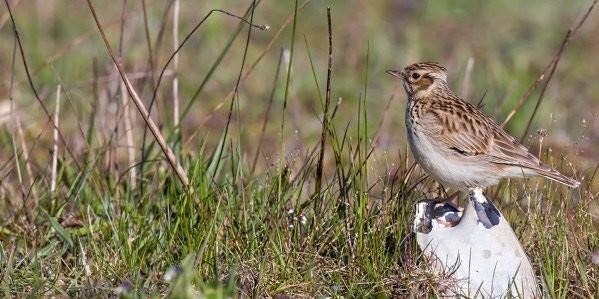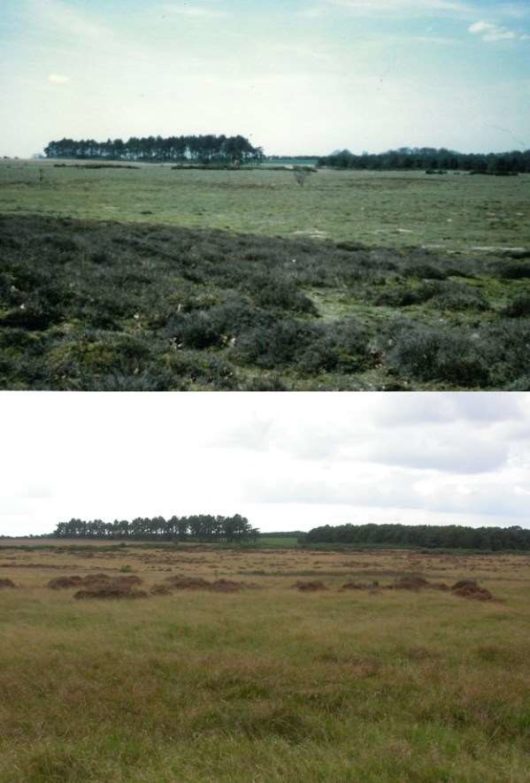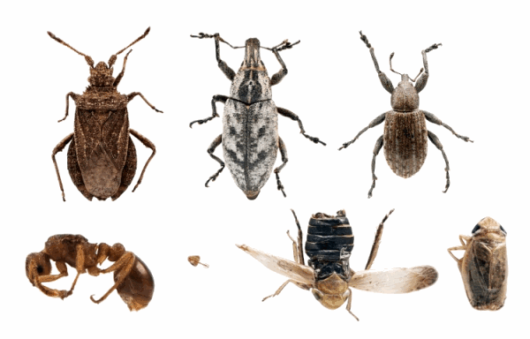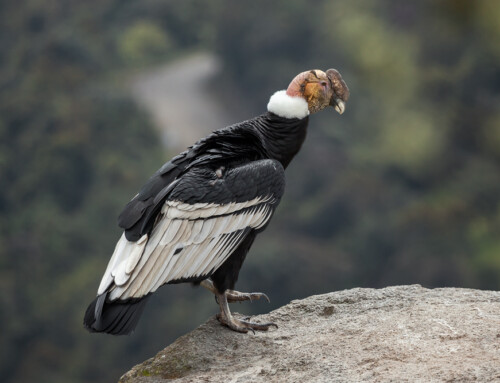
Experimental evidence that ground‐disturbance benefits Woodlark Lullula arborea. Hawkes, R W., Smart, J., Brown, A., Jones, H. & Dolman, P.M. 2018. IBIS. DOI: 10.1111/ibi.12696. VIEW
Conservationists have long tried to determine whether habitat management can aid the recovery of threatened species. Whilst many studies relate population distributions and habitat to inform potential management (e.g. Border et al 2017), experiments that test contrasting management approaches, across a range of habitats, are the preferred means of providing the evidence to support best practice.
In the Europe, management trials have provided the evidence base for some well-known restoration schemes. For example, the UK’s agri-environment scheme prescriptions, designed to reverse the decline of farmland wildlife, have been extensively tested by large-scale, well-replicated experiments (e.g. Siriwardena et al 2007). Whilst this type of experimental approach has been possible within some landscapes (e.g. arable farmland, woodland), management trials are seldom undertaken within lowland semi-natural habitats (e.g. lowland heathland), where patch size often precludes a large-scale trial.
In our study, we took the rare opportunity to trial habitat management techniques for a threatened UK bird species, the Woodlark (Stanbury et al 2017), across the UKs largest grass-heath site (the Stanford Training Area, STANTA; 3,500 ha) and a similar site nearby (Brettenham Heath; 200 ha), in the East of England. In the UK, most Woodlark breed in the lowland heathland (Conway et al 2009), where the species uses tall tussocks of vegetation for nesting and bare or sparse vegetation for foraging (Mallord et al 2007). It is possible the cessation of historic land management processes, which formerly created bare open habitats, is at least partly responsible for recent declines (Figure 1); but it is unclear whether treatments that re-open the heaths can promote population recovery, or whether treatment detail matters.
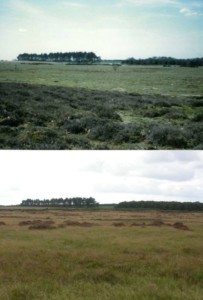
Figure 1 Union Heath, STANTA, in 1996 (top) and 2017 (bottom), illustrating the decline in rabbit populations and the associated loss of bare open micro-habitats © RSPB and Peter Feakes
Implementing a landscape-scale experiment
Our study trialled ground-disturbance management techniques on a landscape-scale, something rarely possible on nature reserves, and examined Woodlark responses as part of a wider multi-taxa experiment (see here for details). Management started in 2015 using two plot-establishment methods (shallow vs deep cultivation, both created using agricultural machinery) across 66 plots. We also identified 36 undisturbed controls (to determine what happens when you do nothing). Disturbance was repeated in early 2016 and 2017, with 26 of the 2ha plots disturbed annually (homogenous plots) and the remaining 40 diversified by cultivating a partially-overlapping 2 ha plot each year, producing a complex-mosaic of subplots that differed in disturbance history and fallow age (complex-mosiac plots). Therefore, although both homogenous and complex-mosaic plots were a similar investment in terms of cost (2ha per year), by 2017 the homogenous plots were still 2ha, whilst the complex-mosaics had become 4ha plots (Figure 2).
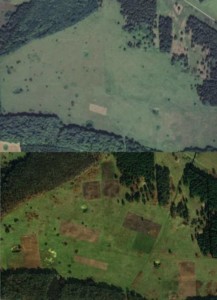
Figure 2 Before (top) and after (bottom) treatment establishment, showing 5/66 ground-disturbance plots, plus one historic plot managed annually (since 2002) for breeding Stone-curlew Burhinus oedicnemus
So, did management influence abundance, and is habitat type and proximity to key landscape features (e.g. woodland) important? The answer is yes, ground disturbance is important, and contrary to an initial prediction that complex ground-disturbance would support a greater increase, treatment type did not matter, every treatment held more Woodlark than controls (Figure 3). Proximity to woodland edge was also important, with plots (whether treated or control) closer to woodland having a higher abundance, and those more than 45 m never holding a territory. Grass-heath habitat (acidic vs calcareous, young grass-heath vs ancient grass-heath) does not matter.
 Figure 3 Mean (± se) number of Woodlark territories per plot (n = 102) for ground-disturbance treatments (see legend for treatment identities) and controls in each of 2015, 2016 and 2017. Note, complex-mosaics were homogenous in 2015 (as fallows were yet to accrue). Click to view larger. Woodlark images: © Claire Buchan
Figure 3 Mean (± se) number of Woodlark territories per plot (n = 102) for ground-disturbance treatments (see legend for treatment identities) and controls in each of 2015, 2016 and 2017. Note, complex-mosaics were homogenous in 2015 (as fallows were yet to accrue). Click to view larger. Woodlark images: © Claire Buchan
Conservation recommendations and next steps
Our extensively replicated landscape-scale experiment suggests that ground-disturbance could be an important conservation prescription for Woodlark in other lowland grass-heaths. Since all the treatments trialled here involved annual disturbance, annual cultivation may be necessary, although treatments that retain bare open habitats for longer (e.g. turf removal) may require less frequent invention. Management needs to be close to woodland edge (within 45 m).
The next step is to determine whether similar management benefits other rare, scarce and threated species, be they plants or animals. So far, a total of 194 species of plant and 765 invertebrate species have been identified: the latter comprising 410 beetles, 112 spiders, 121 true bugs, 22 ants, and 100 bees and wasps. This include Meioneta fuscipalpa, a rare money spider (Linyphiidae) previously known from only one other site in Britain, and Arocephalus languidus (leafhopper, Cicadellidae), a new species to Britain (Figure 4). We advise caution in the widespread use of a single ground-disturbance technique until the wider multi-taxa consequences of this management are known. We will update later!
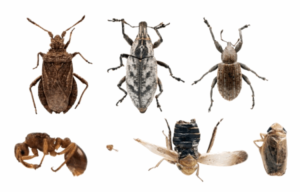
Figure 4 Some of the rare invertebrates identified through this experiment. Clockwise from the top-left; Arenocoris waltlii, Cleonis pigra, Hypera diversipunctata, Arocephalus languidus and Myrmica karavajevi © Annabelle Horton
Nominate this article for a BOU Science Communication Award.
References
Border, J. A., Henderson, I. G., Redhead, J. W. & Hartley, I. R. 2017. Habitat selection by breeding Whinchats Saxicola rubetra at territory and landscape scales. IBIS 159: 139-151. VIEW
Conway, G., Wotton, S., Henderson, I., Eaton, M., Drewitt, A. & Spencer, J. 2009. The status of breeding Woodlarks Lullula arborea in Britain in 2006. Bird Study 56: 310-325. VIEW
Mallord, J. W., Dolman, P. M., Brown, A. F. & Sutherland, W. J. 2007. Linking recreational disturbance to population size in a ground-nesting passerine. J. Appl. Ecol. 44: 185-195. VIEW
Siriwardena, G. M., Stevens, D. K., Anderson, G. Q. A., Vickery, J. A., Calbrade, N. A. & Dodd, S. 2007. The effect of supplementary winter seed food on breeding populations of farmland birds: evidence from two large-scale experiments. J. Appl. Ecol. 44: 920-932. VIEW
Stanbury, A., Brown, A., Eaton, M., Aebischer, N., Gillings, S., Hearn, R., Noble, D., Stroud, D. & Gregory, R. 2017. The risk of extinction for birds in Great Britain. Br. Birds 110: 502-517. VIEW
Image credits
Featured image: Woodlark Lullula arborea © Chris Knights


